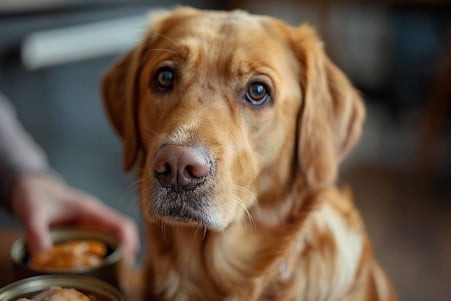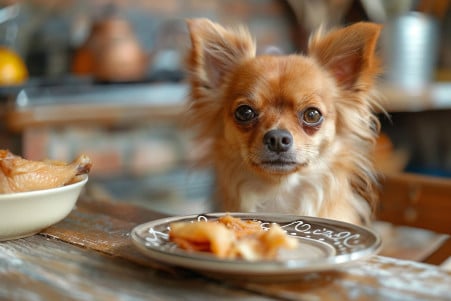How to Boil Chicken Breast for Dogs: Nutritional Facts & Safety Tips
10 March 2024 • Updated 10 March 2024

If you’re a dog owner, you may be wondering if boiling chicken is the answer to all of your pet’s problems. To boil chicken breast for dogs, put boneless, skinless chicken breasts in a pot, cover them with water, and let them simmer until the internal temperature reaches 165°F. Once the chicken has cooled, cut it into bite-sized pieces that your dog can easily eat.
This article takes an evidence-based approach, drawing on information from a range of sources including veterinary nutrition, culinary arts, and animal care to ensure the information is accurate and up to date.
By the time you’re done reading, you’ll know everything you need to know about the nutritional value and safety of boiling chicken breast for your dog, as well as the bigger picture of what this means for your dog’s diet and well-being. This way, you can take a holistic view of how to make this simple, nutritious meal for your dog.
How do you properly cook boiled chicken breast for dogs?
How to Boil Chicken for Dogs: A Detailed Walkthrough
Boiling chicken for your dog is easy and can be a nutritious addition to their diet. Use boneless, skinless chicken breasts to avoid any potential choking hazards and to keep the meat lean.
According to Great Pet Care, the process of boiling the chicken is simple: place the chicken in a pot of water, making sure it’s completely covered. Bring the water to a boil, then lower the heat to a simmer.
Let the chicken cook for 12 to 15 minutes, or until it’s no longer pink in the middle. Make sure the chicken has reached an internal temperature of 165°F to ensure it’s safe to eat and free of bacteria like Salmonella, per the USDA’s food safety guidelines.
Once the chicken has been boiled, let it cool to avoid burning yourself.
Then, cut or shred the chicken into pieces that are appropriate for your dog’s size—smaller dogs will need smaller pieces to avoid choking hazards.
Rocky Kanaka stresses the importance of not adding any spices or seasonings that could be toxic to your dog.
Once you’ve cut it up, you can serve the chicken as is or mix it with rice or plain pasta for dogs with sensitive stomachs.
Keep any leftovers in the fridge to have on hand for easy meals or freeze them to use later, making sure to keep the chicken fresh and safe for your dog.
Nutrients in Boiled Chicken That Are Good for Dogs
In addition to being delicious, boiled chicken is also full of nutrients that are important for your dog’s health. For example, Raised Right points out that chicken is a great source of protein, which is important for maintaining muscle mass and supporting overall growth. Chicken is also high in Omega-6 fatty acids, which are important for skin and coat health, while essential amino acids help support the immune system and organ health.
Meanwhile, the glucosamine found in chicken can help support joint health by keeping your dog’s joints flexible and mobile. Boiled chicken can also be helpful for dogs with tummy troubles. For example, dogs with sensitive stomachs can benefit from a bland diet that includes boiled chicken and rice.
That said, it’s important to note that a diet that consists solely of chicken isn’t ideal. As Aisling O’Keeffe, MVB, explains, while boiled chicken can be a healthy, low-fat addition to your dog’s diet, it’s not a complete and balanced diet that meets all of your dog’s nutritional needs as outlined by AAFCO.
Instead, a diet that includes a variety of proteins, vitamins, and minerals is important to ensure that your dog gets everything they need to stay healthy and avoid nutritional deficiencies.
Safety Considerations for Making Boiled Chicken for Dogs
In addition to the nutritional value of your dog’s food, you also need to consider its safety. Great Pet Care notes that you need to cook raw chicken to an internal temperature of 165°F to kill bacteria like Salmonella. To make sure you’ve reached this temperature, always use a food thermometer to guarantee that your dog’s meal is free of bacteria.
You also need to make sure that you remove the bones and skin from the chicken you give to your dog. According to Aisling O'Keeffe, MVB, a pet nutrition consultant for Raised Right, bones can splinter and cause choking or internal damage, and skin is often too fatty, which can lead to pancreatitis in dogs.
You also need to avoid adding any seasonings, spices, or other additives to the chicken. Even things that are safe for humans to eat, like onions and garlic, can be toxic to dogs, as the CDC notes in its guidelines for handling chicken safely.
When you’re adding boiled chicken to your dog’s diet, it’s important to do so gradually. This way, you can start with small amounts and see how your dog reacts to them, including any signs of allergies or digestive upset.
This way, you can make sure that you’re adding boiled chicken to your dog’s diet in a way that allows them to enjoy the benefits of the food without experiencing any negative side effects. By following these safety measures, you can make sure that you’re preparing a nutritious meal that supports your dog’s overall health and well-being.
Comparing Cooking Techniques for Dog-Friendly Chicken
When it comes to cooking your dog’s chicken, the cooking method you choose is important for both nutritional value and safety. While boiling is a popular option for pet parents, especially when it comes to cooking chicken, how does it compare to other methods like baking, steaming, or frying?
Boiling preserves the omega-3 fatty acid content in chicken, which is important for dogs, better than frying or microwaving, according to a study cited by Healthline.
On the other hand, other cooking methods have their drawbacks. High-heat cooking methods, like grilling, can lead to the formation of harmful compounds, including heterocyclic amines (HCAs) and advanced glycation end products (AGEs), which have been shown to have negative health effects in humans and could potentially have the same impact on dogs, according to Healthline.
Boiling has its advantages as well. It’s a low-heat cooking method that results in minimal loss of amino acids, which are essential for dogs. A study published in PMC found that boiling chicken results in less loss of these important nutrients than roasting.
This means that not only does boiling chicken ensure that it’s safe from bacteria, but it also ensures that it’s the most nutritious for your dog, making it the best way to prepare your pet’s meal.
How to Store Boiled Chicken for Your Dog
Proper storage is important to keep boiled chicken fresh and safe for your dog. Heart of the Canine notes that after boiling, you should cool the chicken and then store it in an airtight container in the refrigerator for up to four days.
For longer storage, the USDA recommends freezing the chicken, which will be safe to eat for up to four months, although it is best to use it within that time for the best quality.
When you’re ready to use the chicken, make sure to reheat it to an internal temperature of 165°F to ensure that any bacteria that may have developed is killed. Southern Living says that you can reheat the chicken on the stovetop or in the oven, but make sure that it is heated to the proper temperature throughout.
Watch for spoilage: if the chicken is discolored, slimy, sticky, or has a bad smell, throw it away. Feeding your dog spoiled chicken can make them very sick, so if you’re in doubt, it’s best to get rid of it. By storing it properly and watching for these signs, you can make sure that the nutritional value of boiled chicken will help keep your dog healthy and strong without making them sick.
How Diet Affects Canine Health and Behavior
The impact of diet on dogs goes far beyond the nutritional value of the food they eat—it can also affect their behavior and overall health. Boiled chicken, for example, is a high-protein food that provides valuable nutrition that supports muscle and brain health. According to researchers at Dogs Naturally, a high-protein diet, especially one that includes chicken, can even improve mood and behavior, proving that a protein-rich diet is important for dogs.
In addition, hydration is an important part of a dog’s diet, and the water in boiled chicken can help dogs get the hydration they need. Research published on PubMed shows that dietary interventions, including the addition of boiled chicken, can affect a dog’s mood and stress levels by impacting the levels of neurotransmitter precursors like tryptophan and tyrosine.
In addition, the Clinical Nutrition Service at Cummings School notes that while the overall diet is the most important factor, the individual components of the diet, including protein, can have a direct effect on a dog’s behavior. It’s important to balance these components to ensure a dog’s overall health and how it interacts with the world.
This shows that food is more than just fuel for the body; it’s also a foundational part of a dog’s life that can affect its health, mood, and behavior.
Conclusion: Boiled Chicken for Dogs
Boiling chicken breast for dogs is so much more than a cooking project—it’s a way to show your commitment to your furry friend’s health and happiness. In this article, we’ve walked you through the process of boiling chicken step by step, making sure to note that an internal temperature of 165°F is necessary to kill bacteria.
We’ve also talked about how the nutritional content of boiled chicken, including protein, essential amino acids, and glucosamine, can help with muscle mass, joint health, and overall well-being.
We’ve also made sure to stress safety by outlining what to avoid when boiling chicken for dogs, including bones, skin, and certain spices. We’ve also talked about the importance of storing chicken properly so that it can be a safe and healthy part of your dog’s diet. And while boiled chicken has many benefits, we’ve also made sure to remind readers that variety is key to a healthy diet.
In conclusion, as you work to give your dog the best life possible, remember that the right diet, including the occasional serving of boiled chicken, can make a big difference in their health and happiness. Always work with your vet to make sure your dog’s diet is tailored to their unique needs, and here’s to the satisfaction of seeing them live their best life on a well-balanced diet.


